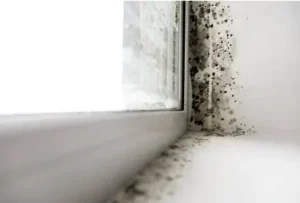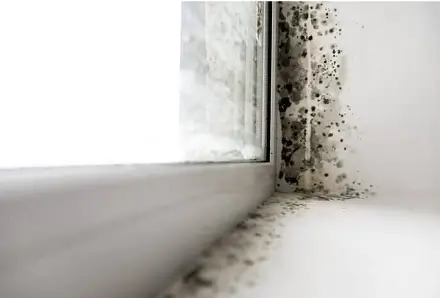Mould Condensation Services

As we all know condensation is caused by warm moisture laden air coming into contact with a cold surface. The small droplets of water support the growth of black spot mould that only grows on condensation not on rising damp. However dampness in a room can cause condensation.
The source of condensation is usually a shower, clothes dryer, flueless gas heater or well used kitchen or laundry. Clothes dryers should be ventilated to the outside and internal laundry doors kept closed during washing and drying operations to prevent moisture-laden air migrating to other parts of the house.
Bathrooms in particular should be used with the door closed the extractor fan on and if possible the window open and should be left this way for half an hour after use. There is a lot of misinformation about mould and its presence in homes. Mould remediation must include the altering of the atmosphere which has caused the mould growth. If this service is not included in any mould remediation process the mould will simply return.
Mould and moisture go together – and condensation is the primary cause of mould growth in Dundee homes during winter. Mould growth forms when mould spores meet up with moisture and a food source.
The most common cause of moisture in any dwelling is typically condensation. So eradicating condensation (which is a ventilation issue) is the fastest way to eradicate mould growths form any building.
Contact us today by calling 01382 787200 or use the online Form to Contact us for a Free Written Estimate.
Our Services

If you’re buying a house and have any worries about existing dampness in walls, please phone or email to arrange an appointment.
Two types of Mould
Visible mould is simply mould growth that can be viewed by the naked eye without reliance on microscopes or swabs. Visible mould forms when mould spores come into contact with food and moisture. A common food source is particles from many common porous materials used in constructing a house – wood, paint etc. With badly contaminated porous surfaces (plaster, wood etc), replacement may be required if cleaning is deemed unsuccessful. Where possible, the area to be cleaned is isolated from the rest of the property to avoid cross contamination.
Non visible mould can only be detected with either monitors which can measure airborne particulates or by the taking of swabs and having them tested under laboratory conditions. Mould spores are invisible airborne particles which are simply one particle which forms the many particles that may be found in normal household dust. In other words, think of mould spores as dust and treat them in the same manner. Apart from any respiratory issues that people may have when confronted with airborne dust particles – asthma, coughing, coughing etc
How to reduce condensation in your home
Produce less moisture.
Let the damp air out and the fresh air in.
Insulate and draught-proof your home.
Heat your home a little more.
Condensation is not the only cause of damp mould
Your home may be experiencing damp for other reasons. Penetrating damp is moisture entering the house through leaking pipes, a damaged roof, blocked gutters, gaps around window frames and cracked rendering and brickwork etc. All these problems can be remedied. Rising damp is due to a defective or non-existent damp course. This will leave a ‘tide mark’ about 1m above the floor. Fixing rising damp is a job for a qualified builder.
Professional Mould Removal Dundee
Some companies involved in the mould remediation industry only clean the mould from the affected areas without considering how or why the mould grew in the first place. This approach is both negligent and a waste of the customers’ money as there is no guarantee that the mould will not regenerate itself. The answer is that the cleaning of the affected areas MUST be combined with both identifying the reasons for the mould generation and then the drying of the areas. One without the other is a waste of time – and cleaning without drying can also be dangerous for occupants’ health, as airborne mould spores will continue to be an issue until the affected area is ‘sterilised’. Typically, our mould remediation jobs involve both cleaning and drying the property simultaneously.
Call us on 01382 787200 or email us for more details or to arrange for a free inspection and a report on mould removal and treatment options.

